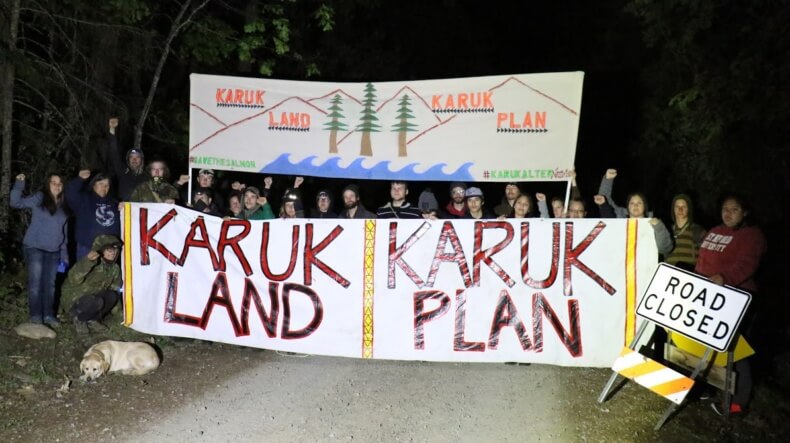By Dan Bacher / Intercontinental Cry
In the early morning hours before daybreak on May 2 in the fire-impacted conifer forest near Seiad Valley in the Klamath River watershed, 27 people including Tribal youth, river advocates and forest activists blocked the road leading to the Klamath National Forest’s Westside salvage logging project.
Demonstrators held banners that read ‘Karuk Land: Karuk Plan,’ recited call and response chants, and testified to the timber sales’ impact on ailing salmon populations. Work was delayed for approximately four hours, according to a news release from the river advocates.
The protesters said the Westside Salvage Logging Project would clear cut more than 5,700 acres on steep slopes above Klamath River tributaries and along 320 miles of roads within Klamath National Forest. Post-fire logging and hauling began in late April, before legal claims brought forth by a lawsuit led by the Karuk Tribe could be considered in court.
“The Forest Service should follow the Karuk Plan on Karuk Land. Traditional knowledge of fire helps everything stay in balance because it’s all intertwined,” said Dania Rose Colegrove of the Klamath Justice Coalition. “When you destroy the forests, you destroy the rivers.”
The protesters said the Westside plan, unlike the Karuk Alternative, calls for clear cut logging on steep slopes right above several of the Klamath River’s most important salmon-bearing streams, at a time when returning salmon numbers are reaching record lows.
Members of local Tribal youth councils who participated in the protest see Westside salvage logging as a threat to their future.
“Today I showed up and stood up for what is right for future generations,” said Lacey Jackson, a 16-year old Hoopa Tribal Youth Council member. “My cultural and traditional livelihood is being threatened, and the way they are going about this logging is a big part of that. I will continue to stand up for me, my people and future generations.”
River advocates say the Forest Service plan to clear-cut thousands of acres above the Klamath River disregards the reasonable Karuk Alternative and hurts at-risk salmon and river communities. They believe a healthy Klamath River requires sensible forest restoration that addresses the needs of both fish and people, like that laid out in the Karuk plan.
Federal and state fisheries agency scientists estimate that there are only approximately 142,200 Klamath River fall-run Chinook salmon in the ocean this year, based on the returns of two-year-old salmon, called “jacks” and “jills.” The salmon from the Klamath and Sacramento River make up the majority of salmon taken in California’s ocean and inland fisheries.
The low numbers of Klamath and Trinity River fish expected to return to the river and tributaries this year will result in more restricted seasons for both the recreational and commercial fisheries on the ocean and recreational and Tribal fisheries on the rivers this season.
During a meeting on Klamath dam removal in Sacramento in March, Thomas Wilson, a member of the Yurok Tribal Council and owner of Spey-Gee Point Guide Service, described the dire situation that the salmon fishery is in this year.
“This season will be devastating for fishermen and people on the river. Usually we get around 12,000 fish for subsistence on the river and what’s left goes to the commercial fishery. This year our entire Tribal quota is only about 5,900 fish,” he explained.
“The people are praying that the science predicting the low numbers is wrong. If we don’t protect the fish now, it will hurt us down the road. As Yuroks and natives, we are conservationists. We want make sure enough to keep seed for the all of the resources for future generations,” Wilson said.
The last thing that the watershed needs, at a time when the fishery is in crisis, is a Forest Service-approved clear cutting plan that further threatens salmon and steelhead habitat.


I love the Klamath River; I visited near that stretch several times several years ago, thinking about moving there. It’s crazy to clearcut anywhere, of course, but especially on those steep mountains.
I hope local resistance finds ways, via aboveground or underground action, to shut down the devastation.